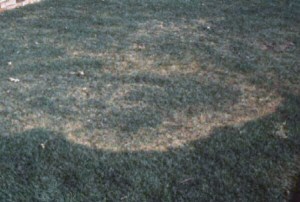Large Patch of Zoysiagrass
 Causal Agent
Causal Agent
The fungus, Rhizoctonia solani
Hosts
Zoysiagrass
Symptoms
In Oklahoma, Large Patch of Zoysiagrass is most commonly seen in early April through May. Diseased Zoysia can be new patches or perennial patches from previous years. Spring patches are visible in April as light brown sunken areas that recover slowly from winter dormancy while healthy turf around the patches greens up more rapidly. Patches may expand and show a bright orange border. The fungus is most active at thatch temperatures between 50 and 86 degrees F. By late May, thatch and soil temperatures are high enough to stop the spread of the disease. In the fall, thatch temperatures are lower and the disease becomes active again. From late September to mid-October, roughly circular patches of bright orange discolored turf appear. These patches later fade to a tan color. The outer ring of the patch will usually remain bright orange in color as it continues to expand. Grass shoots on the outer edge of the patch may develop reddish-brown to black lesions on the lower leaf sheaths on the plant. The enlargement of the lesions eventually girdles the plant and cuts off the water and nutrients supplied to the shoot. Some uninfected Zoysiagrass as well as other turfgrass species and weeds will remain uninfected and grow rapidly inside the patch. Infected areas range in size from 6 inches to 20 feet in diameter.
Control
Managing for Large Patch prevention and recovery - Severity of Large Patch Disease can be reduced though not necessarily cured through proper lawn management. As Large Patch does not usually kill stems or roots, the infected areas can heal over very quickly in warm weather in the Zoysia turf is properly managed.
Watering and Drainage - Proper irrigation and drainage of Zoysia areas are critical in controlling this disease. Large Patch of Zoysiagrass is favored by very wet soil or wet thatch and is most severe in low or poorly drained areas. Low areas should be regraded for proper surface drainage. Tiling slit trenches can be used to assist in drainage of water through the soil. In severe cases, sod should be removed with a sod cutter and sand should be tilled into the soil to improve soil drainage characteristics. Zoysia should be watered when it first begins to foot print or wilt. Water such that there will not be standing water. Additionally, if a Zoysia area needs water, it should be watered in the early morning hours (5 to 9 am) to lessen the period of leaf wetness that favors disease development.
Mowing practices - The fungus causing the disease can be easily spread over an area if the area is mowed or tread over by people or equipment when the turfgrass leaves are still wet. Mow infected Zoysiagrass areas only after the turf has dried off. Severity of Large Patch of Zoysia increases with lower mowing heights. Try to maintain Zoysiagrass at 1 to 1 1/2 inches in height.
Fertilization - Zoysiagrass that is already established should be fertilized with no more than 3 pounds of nitrogen per 1000 sq. feet per year. Apply this amount of nitrogen in three separate and equal applications.
Core aerifying, power raking or dethatching - Zoysiagrass areas should not be disturbed by aerification or dethatching when Large Patch of Zoysia is active (spring and fall). Perform these activities once the soil and thatch have warmed up and the disease is no longer active.
Fungicidal Application - Fungicides can help control Large Patch of Zoysia. The timing of spray application of the fungicide is very important. Ideally, fungicides should only be applied to areas which are likely to have a reoccurrence of the disease. Areas that were infected in the previous spring or fall are more probable locations for the disease to occur than areas that were not previously infected. Fungicide application should be made prior to the occurrence of infection. Always read and follow fungicide label directions. The label is the law. The following fungicides have been successful in suppressing Large Patch of Zoysiagrass in this region of the country and are labeled for this use: Chipco 26019, Banner, and Prostar. The turfgrass fungicides Lynx and Eagle have been found successful in suppressing Large Patch of Zoysia, but were not labeled specifically for control of this disease. Homeowners should consider the use of a professional pest management service to apply fungicides, as i) packaging size may not be convenient or practical for homeowners, ii) the fungicide labels may preclude purchase or application of the material by nonprofessional turf managers, or iii) homeowners may not possess proper fungicide application equipment. Please contact your local county extension office for current information.

